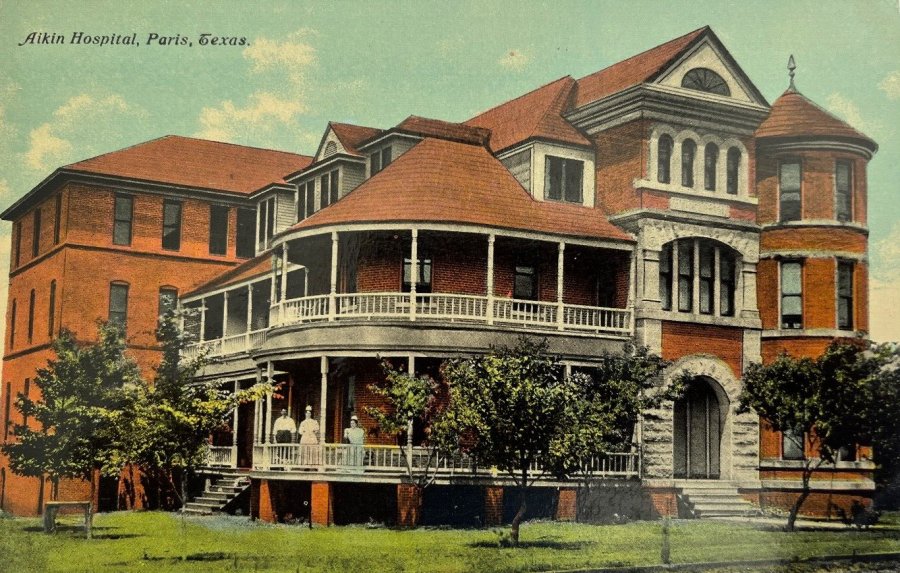|
The Jenkins Family Thomas William Jenkins Thomas William Jenkins, born June 17, 1848 in either South Carolina or Georgia, was the eldest son of Lorenzo Clark Jenkins and his first wife Cornelia. Thomas grew up on a farm at or near Carnesville, Franklin County, Georgia. Family lore holds that in 1869, when he was twenty-one, T. W. Jenkins and his eighteen-year-old brother Benjamin Franklin Jenkins saddled their horses and left their home in Franklin County, Georgia, bound for Texas. An unsubstantiated family story holds that young T. W. left behind a bride in neighboring South Carolina because she refused to leave her mother, or that he divorced her before leaving for Texas. Another story, equally unproven, has it that after the Civil War, T. W.’s father, Lorenzo Jenkins, left Georgia, taking the family with him to Illinois. It was there or in the Indian Territory, so the story goes, that young T. W. Jenkins met the girl we know he married. We cannot be certain that either of these stories are true. In the opinion of this writer, there may be something to the first but the second seems particularly implausible. The only thing we can be sure of is that T. W. and his brother did go to Texas, although we can't bs sure when they arrived, or where. Neither Thomas W. Jenkins nor his brother Benjamin F. Jenkins can be found in the 1870 Federal Census for Texas or any other state. Ellie Thompson Jenkins, second wife of Benjamin F. Jenkins, told a slightly different story. According to her, Ben left Georgia at the age of fifteen and traveled to Texas "with a company of people in 16 wagons," which presumably included his older brother, Tom. This would have been 1867, not 1869. The journey, she said, took two months and young Ben "had to walk most of the way." By the time he arrived, he had "chills and fever," but evidently recovered, because, as Ellie reports, he spent eight years as a cowboy and then, after meeting his wife in Kansas, they married and settled in Johnson County, Texas.
Although his brother, Ben, would eventually join him in Lamar County, Texas, our first known public record of Thomas W. Jenkins is in Hunt County, where at Greenville, on December 6, 1874, Thomas William Jenkins married Louisa Williams, the twenty-four year old daughter of John I. Williams, a native of Illinois who had brought his family to Texas sometime between 1858 and 1860. In 1875, Louisa gave birth to her first child, a daughter who was named Delilah Emmeline or "Emma." According to family lore, Louisa herself had an unusually long name. Apparently, when she was born in 1850, her mother Delilah decided to name the girl for every one of her (Delilah’s) sisters. As a result, Louisa’s entire name was Louisa Iodine Spicy Ann Susan Elizabeth Ludicy Katherine Williams. This story is partly substantiated by the 1860 federal census for Hunt County, Texas, which lists one John Williams with a wife named Delila and a daughter named "Spicy A." During their sojourn in Hunt County, Louisa Jenkins gave birth to two children. The first was a girl, Delilah Emmaline, born November 17, 1875. The other was a boy, John Clark Jenkins, born June 12, 1877. Sadly, the boy died in infancy, on February 10, 1878. During the first four years of their marriage (1874-1878), T. W. and Louisa Jenkins apparently lived on a farm about 4 miles north of Greenville, that they bought from one J. M. Lowrey (date not known). The land was part of a larger tract originally known as the John C. Bates survey. Curiously, T. W. Jenkins does not appear on the roll of Hunt County taxpayers until 1877. This property was located on the Cow Leach fork of the Sabine River. Deed records in the Hunt County courthouse confirm that the couple owned 100 acres but sold it, in two parcels, in 1876 (60 acres, for $500; Hunt County Deed Book U, pp546-7) and 1878 (10 acres for $125; Hunt County Deed Book X, pp.451-2). It appears that afterward, sometime during the fall of 1878, Thomas and Louisa removed to neighboring Lamar County, where they had purchased a 105 acre tract "on the waters of Pine Creek, a tributary of [the] Red River…about 8 miles North West from Paris." (Lamar County Deed Book 2-H, pp. 122-3)
On November 13, 1878, shortly after moving to Lamar County, T. W. Jenkins sold his Pine Creek property for $300. On the very same day, he paid $300 to the same couple who bought his Pine Creek land (a John or Joseph Dolman and wife), for two tracts, one of 187 1/2 acres--part of the 582-acre tract patented by Franklin Darnell as assignee of the Texas and New Orleans Railroad--and the other--part of a 160-acre survey originally granted to P. H. Birmingham--measuring 40 acres. Because the selling price in each transaction was $300, it seems unlikely that any money actually changed hands. In all likelihodd, this transaction was simply an even trade. There is no doubt that the 187 1/2 acre tract was the principal residence of Thomas W. Jenkins and his wife, Louisa, from 1978 until shortly before their divorce in the early 1900s. The land was located within the south middle portion of what is now the Camp Maxey Army National Guard Training Site, just north of Lamar Lake. This area, originally granted to the Texas and New Orleans Railroad, is marked A-949 (A=Abstract) on the Lamar County Appraisal District map. This new Jenkins farm was situated about eight miles north of Paris, the seat of Lamar County, and just under seven miles south of the Red River, which marks the boundary between Texas and Indian Territory (now Oklahoma). The nearest community was a little town called Powderly. It was here about 1879 that Louisa Jenkins gave birth to her second child, Thomas Benjamin. He was followed, in somewhat rapid succession by William Newton (born December 20, 1881), George Christopher (born September 9, 1883), and Lorenzo Russell (born March 8, 1885). The 40-acre tract purchased in 1878 was located several miles northwest of Paris, almost to the Fannin County line. The original Birmingham survey is designated A-124 on the Lamar County Appraisal District map. Precisely what T. W. Jenkins did with this land is unknown, but we may guess that he rented it to one or more tenant farmers. The first child born to Louisa and T.W. Jenkins following their move to Lamar County was Thomas Benjamin Jenkins, who arrived on January 30, 1879. His brother, William Newton Jenkins, followed on December 20, 1880. On November 9, 1882, T. W. Jenkins purchased a further 40acres of the old P. W. Birmingham survey, about ten miles north of Paris according to the deed, from Leo Hamilton and his wife, Florence, for $40 (a dollar per acre). This land was adjacent to the 40-acre tract, northwest of Paris, that he purchsed from the Dolmans in 1878. (Lamar County Deed Book P, p. 25) On September 9, 1883, Louisa Jenkins gave birth to her fifth child and fourth son, George Christopher Jenkins. On November 28, 1884, T. W. Jenkins purchased more property for which, unfortunately, I do not have a copy of the deed. However, from information gathered from another, later deed, apparently this property was located much closer to Paris, probably within the present-day city limits. The sellers were Leo and Katie Harrison. On March 8, 1885, Louisa Jenkins gave birth to another boy, Lorenzo Russell Jenkins, obviously named for his paternal grandfather back in Georgia. Seven months later, on October 10, 1885, his two-year-old brother, George Christopher Jenkins. died of causes that have been lost to history. Sadly, Lorenzo Russell Jenkins also died at the age of two, (cause also unknown) on October 12, 1887, almost exactly two years to the day that George Christopher died. The burial place of both boys is unknown, but nearby Long Cemetery is a possiblity.
T. W.’s job as a mail carrier brought him a modest income of $150 a year. But certainly, he and Louisa were in need of it. Over the next four years, two more children were born: Andrew Jefferson (born February 20, 1887) and Pearlee Margaret or "Maggie" (born September 15, 1889). These were followed, in the 1890s, by another two: Susan Zobedia or "Beadie" (born September 29, 1893) and Sada Elizabeth, the last child (born January 4, 1898). Around 1892, T. W.’s and Louisa’s daughter Emma Jenkins married David Andrew Morrison, the son of one of the family’s nearest neighbors. Not long afterward, the older couple became grandparents when Emma’s first child, Christopher Columbus Morrison, was born. Why Christopher Columbus? Well, in 1893, when baby "Lum" arrived, the four-hundredth anniversary of the discovery of America by the famous Italian navigator was being celebrated (a year late) at the World’s Columbian Expostion in St. Louis, Missouri. Surely, this event was the inspiration for his name. The Morrison and Jenkins families seem to have been very close. About 1894, when T. W. and Louisa sat for a formal portrait with six of their children, not only were their son-in-law and baby grandson included but also Janey and Emmerine Morrison, two of Emma Jenkin’s Morrison’s new sisters-in-law.
Around the same time period, T. W. and Louisa posed for a formal portrait on their own. In appearance, they seem like an "odd couple." Dressed in a dark, three-piece suit, T. W. is of average height, thin, with a mustache and Buffalo Bill-style goatee. Louisa, only slightly shorter, stands to her husband’s left. She is a large, buxom woman wearing a white blouse and a dark, floor-length skirt. Each has a hand resting atop the back of a chair. They seem stiff and ill-at-ease.
On July 14, 1900, a second Jenkins-Morrison union occurred when William Newton Jenkins, age eighteen, married his brother-in-law’s sister, Emmerine J. Morrison, less than two weeks before her twenty-sixth birthday. In an age when men traditionally married younger women, (oftentimes many years younger) the groom being six years younger than the bride was something out-of-the-ordinary. Be that as it may, this union, which produced three children, was short-lived. In February 1904, after contracting blood poisoning (possibly as a result of child-birth), Emmerine Jenkins died. In two separate transactions, one in December 1900 and the other in April 1901, T. W. Jenkins purchased a total of 12 acres of land from one John W. Rountree, part of the Reddin or Redding Russell survey, located about 1 1/2 miles northeast of Paris (Lamar County Deed Book 96, p. 275 and Deed Book 99, p. 20). He did not keep this property very long, however. On March 22, 1909, he sold all 12 acres back to Rountree for $300 (Lamar County Deed Book 130, p. 91). On August 13, 1903, to correct the surveyer's field notes, J. W. Ownby and others deeded 31.59 acres of the Reddin or Redding Russell survey, about two miles north of Paris (but now within the city limits), to T. W. Jenkins. The cost to him was $1. (Lamar County Deed Book 113, p. 11). Because reference is made in this deed to the sale of land to Jenkins by the Harrisons in 1884, the land described in this deed does not appear to be a separate piece of property, but merely a boundary adjustment to a tract already owned by Jenkins. Without the 1884 deed to go by, however, it is impossible to know precisely. However, we do know that that very same year, T, W. sued the City of Paris for creating a nuisance by using an adjacent ten acres as a city dump. Jenkins said that the foul odor the dumping created lowered the value of his property, making it un-rentable. Claiming that the property was worth $4,000, he asked for $3,500 damages, but after the case was tried, he was awarded only $175. Despite the small amount of the award, the City appealed the case and in 1909, the decision of the earlier court was reversed and remanded. (The Texas Civil Appeals Reports, vol. 57 (Chicago: T. H. Flood & Co., 1911), 383-6. On February 4, 1903, for $400 ($200 cash, plus a promissory note of $200 at 10 percent interest), T. W. Jenkins and wife, Louisa, sold 40 acres of his farm to his son, Willian Newton Jenkins (Lamar County Deed Book 105, pp. 244-5), and another 40 acres to his son, Thomas Benjamin Jenkins (Lamar County Deed Book 105, p 248), also for $400. On October 4, 1911, two days before he died, he sold 35 1/2 acres to his daughter, Zoebedia Jenkins Hale, and her first husband, Harry (Lamar County Deed Book 137, p. 426), and 32 acres to his daughter Maggie Jenkins Cunningham and her husband (Lamar County Deed Book 137, p. 385). In each of the sales to his daughters, the amount paid was one dollar. These reductions left him 31 acres of the original 187 1/2 that he purchased in 1878.
On December 31, 1903, T. W. and Louisa's youngest daughter, Sada Elizbeth Jenkins, died at the age of five. Her brother, Andrew, died almost exactly two years later, on December 29, 1905, at the age of eighteen, from typhoid fever. He was buried two days later, but the name of the cemetery (probably Long) has been lost to history. Sometime between 1903 and 1910, T. W. Jenkins and his wife, Louisa, were divorced. We do not know precisely when or wwhy. Nevertheless, in 1910, when he was sixty-two years of age, the federal census-taker found T. W. living alone in a house on North Lee Street in Paris. The family of his nephew, Benjamin Franklin Jenkins, Jr. (the son of T. W.’s brother Benjamin) lived next door. His ex-wife lived with their son William Newton Jenkins, his new bride Celeste, and their children, probably on their farm near Powderly. In January 1911, T. W. Jenkins traveled to Dallas, almost certainly by train, for some reason that has been lost to history. The station he departed from was not the grand old Union Station, which still stands today on Bonham Street, because it was not built until the following year (1912). In all likelihood, he left from the Texas and Pacific station that still stands next to the old T.&P. tracks, between Main and Church Streets, about five or six blocks directly south of the county courthouse. From there, he almost certainly traveled west to Sherman, where he could change to a Houston & Texas Central train that would take him directly to Dallas.
Around 9:30 p.m. on January 8, 1911, shortly after he arrived in Dallas, he was walking "up Main Street" in what is now known as the "Deep Ellum" section of Dallas, looking for a hotel, when he was held up by two black men, who robbed him of $17 "near the corner of Main and Crowdus." According to a report in the Dallas Morning News, the money that was stolen "consisted of one $5 bill, two $2 bills, one $1 bill, and $7 in silver [coins]." The paper did not mention if the thieves were ever caught or how T. W. was going to pay for a hotel now that he had no money! We may presume (or at least, hope) that he had some other money (hidden, perhaps, in his shoe), and was thus able to find and pay for some accommodation, and that he still had his return ticket back to Paris. (See Dallas Morning News, January 9, 1911.)
Because he died intestate (without a will), T. W. Jenkins' estate was probated, with his son, Thomas Benjamin Jenkins being appointed administrator. Thomas' inventory of his father's possessions, made in November 1911, shows that although T. W. was living in Paris when he died, he still owned eighty acres of rural land and some livestock, including several cows, pigs, and mules. Like his grandmother, Dorothea Jenkins, and his brother, Benjamin F. Jenkins, he had been a beekeeper, having no fewer than fourteen hives. Althugh the inventory of farm animals may have been correct, Thomas' estimation of his father's real property was incomplete. Unless T. W. somehow disposed of it in some way other than by deed or gift, at the time of his death, he not only still owned two 40-acre tracts in the western part of the county, but also 31 acres of his original 1878 farm, as well as the 31.58 acres of land, which the City of Paris had allegedly ruined by placing a dumping ground next to it. A deed on file in the Lamer County clerk's office shows that after T. W.'s death, his heirs (widow and ex-wife Louisa I. Jenkins, son William Newton Jenkins and wife Celesta, son Thomas Benjamin Jenkins and wife, Sarah, daughter Emma Jenkins Morrsion and husband, David Andrew Morrsion, daughter Maggie Jenkins Cunningham and husband, John Cunningham, and daughter Zobedia Jenkins Hale, and husband, H. R. Hale, sold the 31.58 acre tract near Paris to one L. Townsend, for $1,450, which presumably they split between them. (Lamar County Deed Book 141, pp. 643-4) In 1913, Louisa Jenkins was living in Paris at 1025 North 29th Street, where she was assessed $500 in property taxes. Her son, William Newton Jenkins, his wife "Lestie," along with William’s three children by his first wife, lived with her. She had previously resided in Paris with daughter "Beadie" Hale (later, Chennault) and her husband, Harry. The following year, on March 28, 1914, Louisa died of cancer at the Aiken Hospital. She too is buried in Paris’ Evergreen Cemetery, but the location of her apparently unmarked grave is unknown.
A deed on file in the Lamar County courthouse shows that on January 25, 1915, the above-named heirs, minus their late mother, sold another 30 acres of property, located about five miles north of Paris, part of the Sam Worthington survey, to L. Townsend. (Lamar County Deed Book 145, p. 292) This was land that presumably their father, T. W. Jenkins, had acquired at some point, although precisely when is unknown. Another deed, dated July 3, 1915, appears to be a sell-off by T. W.'s heirs, of the remainder of the 187 1/2 acres that he bought in 1878. Curiously, although there should have been only 31 acres left over, after he had sold portions to his sons and daughters, the deed is for 35 1/2 acres. The seller, again, was one L. Townend. The price: $700 (Lamar County Deed Book 154, page 28). What became of T. W. Jenkins' two 40-acre tracts in the western part of Lamar County is unknown.
The Jenkins Family
This website copyright © 1996-2024 by Steven R. Butler, Ph.D. All rights reserved. |


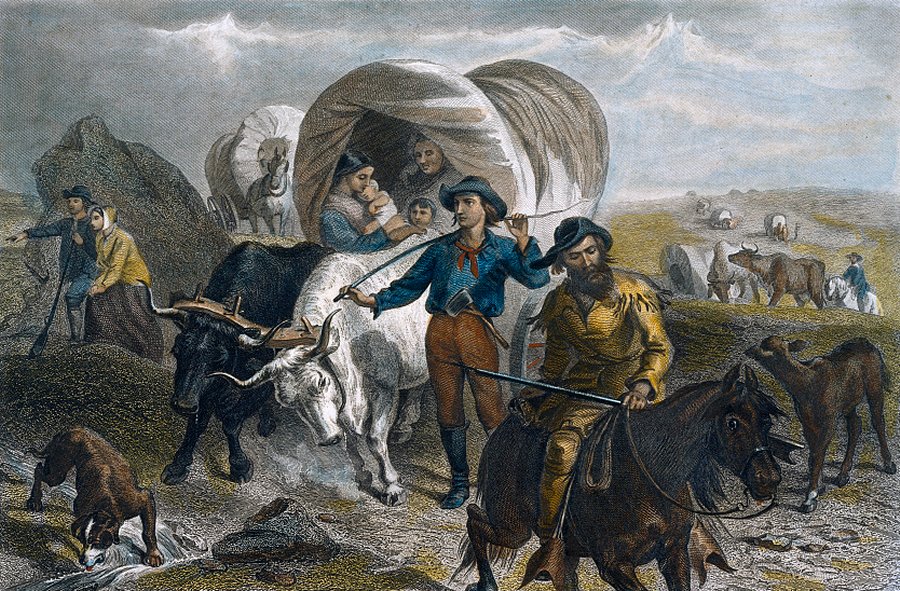
 in Hunt Co TX 5-18-24.jpg)
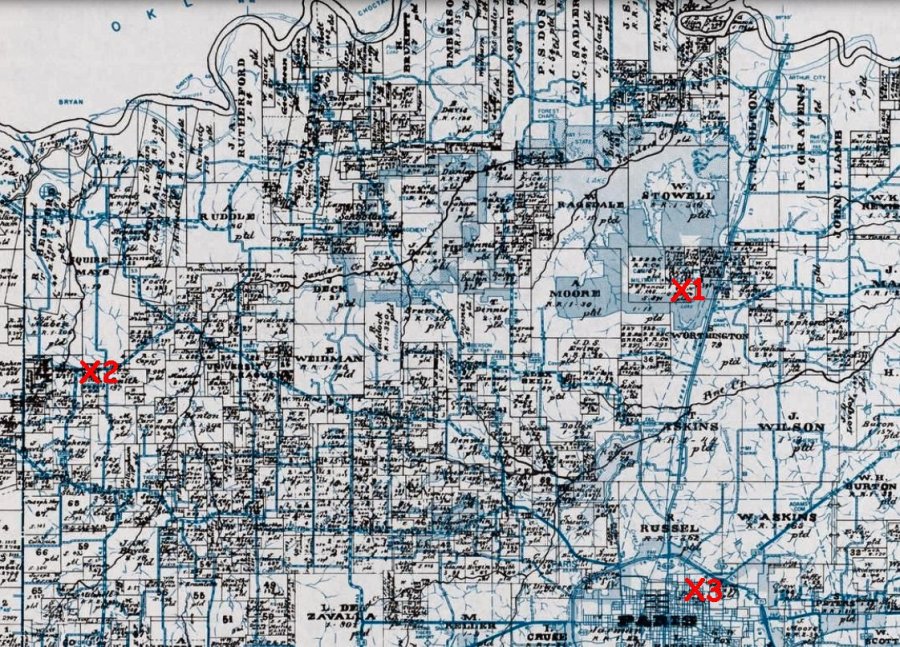
.jpg)
.jpg)
.jpg)
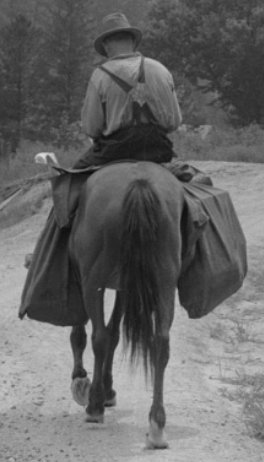 Although he was primarily a farmer by occupation, it appears that his growing family led Thomas William Jenkins to seek some way to supplement his income. In the summer of 1886 he obtained a four-year contract with the U.S. Post Office Department to deliver the mail between Paris and Chicota, a town which lay on the south bank of the Red River, a few miles north of his home. The distance between the two points was about 15 or 20 miles and his route took him through Powderly. Consequently, we may imagine that he often stopped at home for lunch. He fulfilled his duty, we may also imagine, either on horseback, carrying the mail in leather saddlebags, or by driving a horse-drawn buggy. Given the poor state of the roads at that time (most were only dirt trails), the former seems the most likely scenario.
Although he was primarily a farmer by occupation, it appears that his growing family led Thomas William Jenkins to seek some way to supplement his income. In the summer of 1886 he obtained a four-year contract with the U.S. Post Office Department to deliver the mail between Paris and Chicota, a town which lay on the south bank of the Red River, a few miles north of his home. The distance between the two points was about 15 or 20 miles and his route took him through Powderly. Consequently, we may imagine that he often stopped at home for lunch. He fulfilled his duty, we may also imagine, either on horseback, carrying the mail in leather saddlebags, or by driving a horse-drawn buggy. Given the poor state of the roads at that time (most were only dirt trails), the former seems the most likely scenario.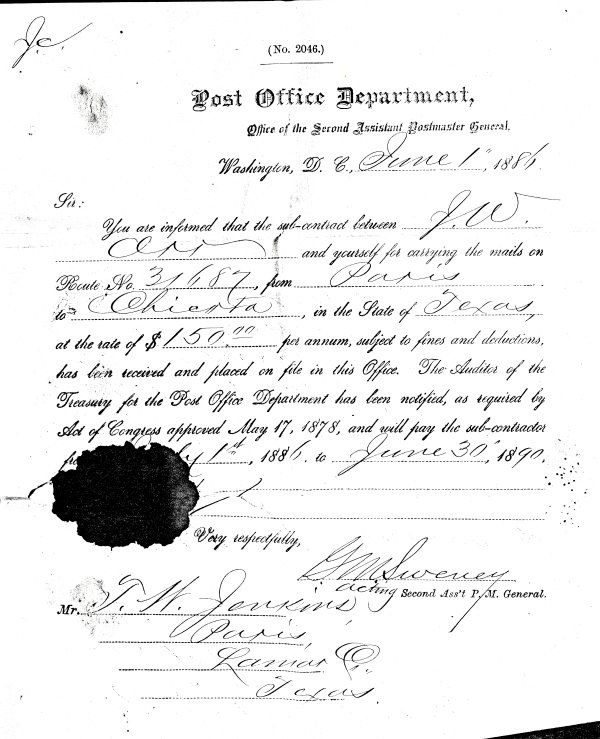
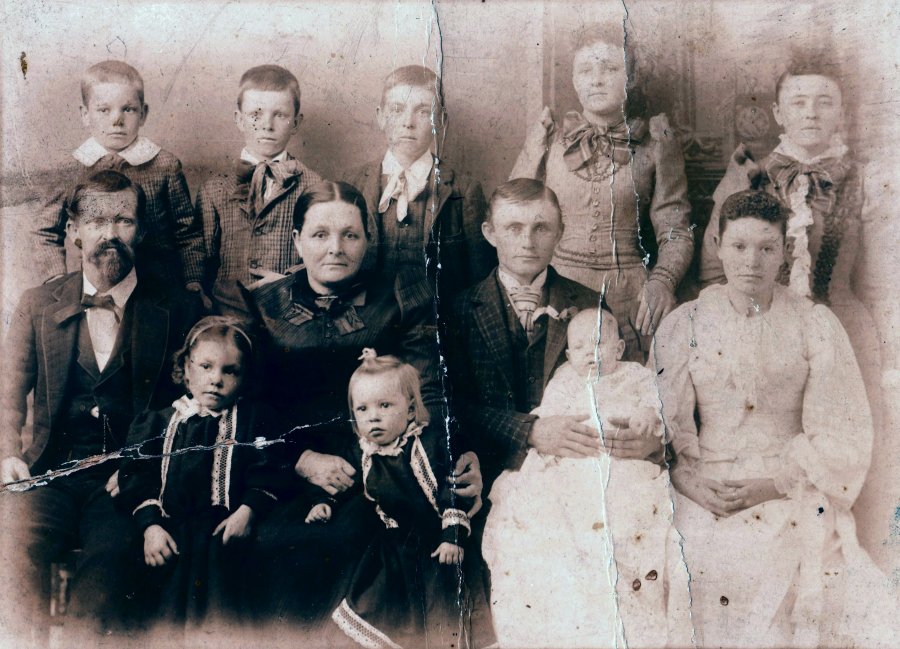
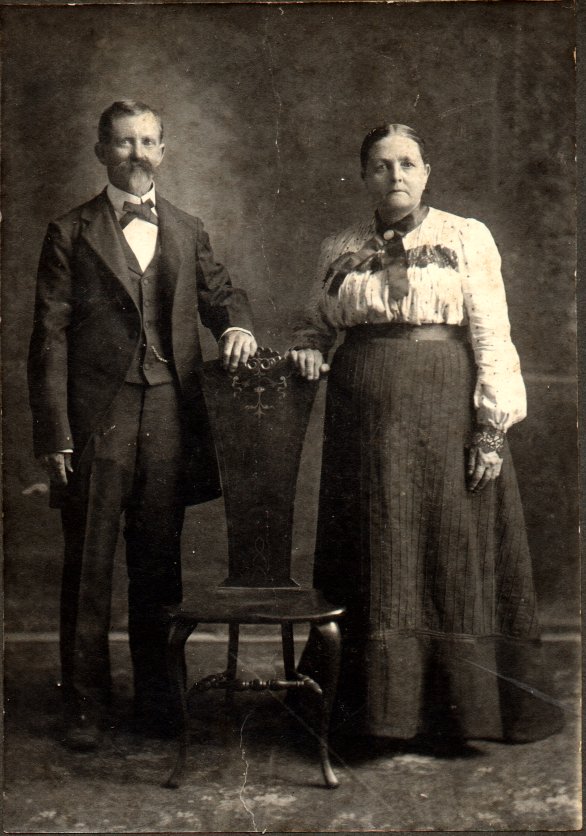
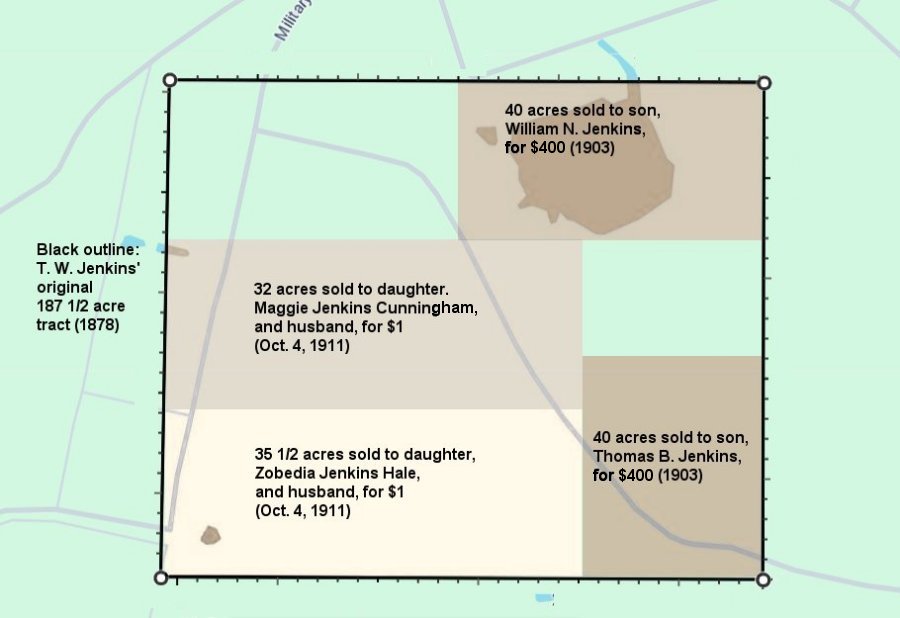

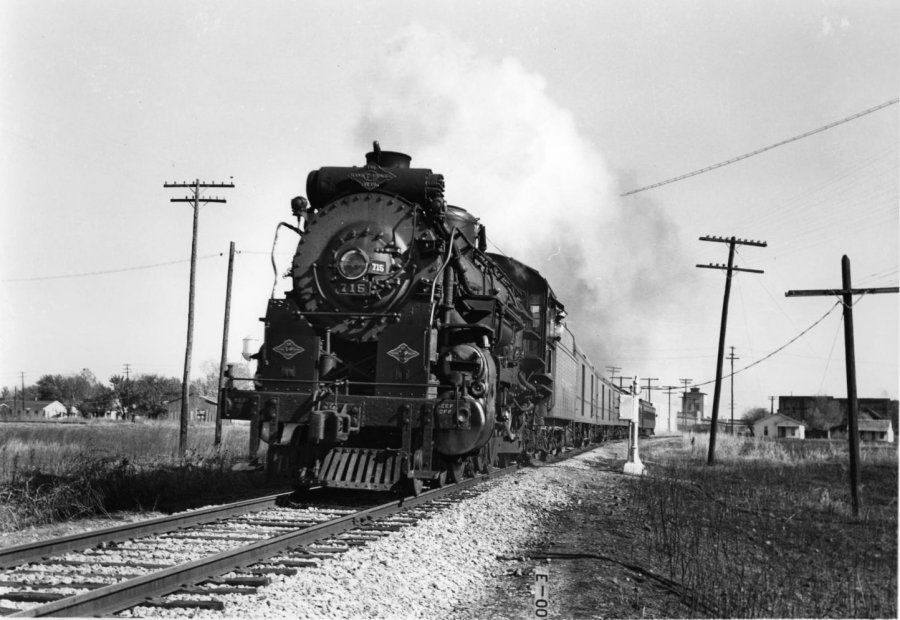
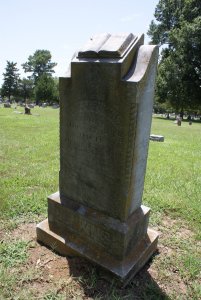 At 1:20 a.m. on Friday, October 6, 1911, at his apparently rented home in northeast Paris, at the corner of Booth and 29th Street (now 11th), T. W. Jenkins passed away at the age of sixty-three. It appears that he was under the care of a physician, Dr. P. A. Spain, at the time. Cause of death: "Congestion of stomach and bowels." Incredibly, very little time passed between his death and burial. His funeral service was conducted at his home, at 3 p.m. in the afternoon of the very same day he died. Afterward, T. W. Jenkins was laid to rest in the far northeast corner of Evergreen Cemetery, in Paris. A grave marker was erected some time later. (See photo left, of T. W. Jenkins grave marker.)
At 1:20 a.m. on Friday, October 6, 1911, at his apparently rented home in northeast Paris, at the corner of Booth and 29th Street (now 11th), T. W. Jenkins passed away at the age of sixty-three. It appears that he was under the care of a physician, Dr. P. A. Spain, at the time. Cause of death: "Congestion of stomach and bowels." Incredibly, very little time passed between his death and burial. His funeral service was conducted at his home, at 3 p.m. in the afternoon of the very same day he died. Afterward, T. W. Jenkins was laid to rest in the far northeast corner of Evergreen Cemetery, in Paris. A grave marker was erected some time later. (See photo left, of T. W. Jenkins grave marker.)